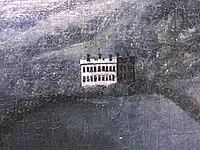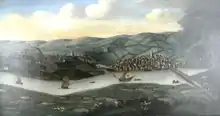


_BarnstapleGuildhall_Devon.jpg.webp)
Pilton House in the parish of Pilton, near Barnstaple, North Devon, Ex31, is an historic grade II listed Georgian mansion house built in 1746 by Robert Incledon[1] (1676-1758), twice Mayor of Barnstaple, who was from nearby Braunton. It is situated almost in the centre of the ancient town of Pilton, but had formerly extensive grounds covering at least 20 acres, which extended down "Pilton Lawn", now built over, to the River Yeo. It later served as the residence for various Members of Parliament for Barnstaple, for which it was well suited being only a 10-minute walk from the centre of that town, yet in a secluded situation with extensive grounds, and sufficiently large and grand for entertaining borough officials and electors.
History
No records detailing the history of the site of Pilton House before the 18th century survive on available title deeds.[4] It is believed to occupy the site of the demolished mediaeval Pilton Priory.[5] Reed (1985) states that the site was part of the Pilton Priory lands purchased following the Dissolution of the Monasteries by the lawyer George Rolle (d.1552) of Stevenstone,[4] founder of the influential and wealthy Rolle family, and quickly re-sold by him in 1545 piecemeal and at a profit.[6]
Ownership
Pilton House was built in 1746 by Robert Incledon (1676-1758), a lawyer of New Inn, London, Clerk of the Peace and Deputy Recorder of Barnstaple[7] and twice Mayor of Barnstaple, in 1712 and 1721.[8] He was a member of the local ancient gentry family of de Incledon (later Incledon, pronounced "Ingleton"), which originated at the estate of Incledon, in the parish of Braunton, which family is first recorded in 1160.[9] In 1806, Robert's son, Benjamin Incledon (1730-1796), "The Antiquary",[10] sold Pilton House to James Whyte; in 1849, beset by financial difficulties, Whyte put the estate up for sale.[4] The next owner was Sir William Fraser, 4th Baronet (1826-1898), a politician, author and book collector.[11][12]
By 1880, Pilton House was the residence of Charles Henry Williams (1834-1908; known as Charles Henry Basset, from 1880), a naval and military officer, JP and Deputy Lieutenant for Devon, and Conservative Party Member of Parliament for Barnstaple, 1868–1874.[13] He was master of the Devon and Somerset Staghounds between 1887 and 1893, and provided much assistance in establishing the Barnstaple Staghounds, for which purpose he provided Pilton House as occasional accommodation for hounds and hunt staff when hunting in the vicinity.[14][15]
In 1893, the occupant was Major General Hugh Chichester (1836-1896), JP, of the Royal Bengal Artillery,[16][17] Of an ancient family seated at Raleigh, Chichester's great-grandmother was Amy Incledon, eldest daughter of Robert, who built Pilton House.[18]
In 1948 the estate was acquired by the Barnstaple Old People's Housing Association and continues in that use in 2014.
Sources
- Reed, Margaret A., Pilton: Its Past and Its People, Barnstaple, 1985
- Burke's Genealogical and Heraldic History of the Landed Gentry, 15th Edition, ed. Pirie-Gordon, H., London, 1937, pp. 2390–1, pedigree of Incledon-Webber of Buckland
- Vivian, Lt.Col. J.L., (Ed.) The Visitations of the County of Devon: Comprising the Heralds' Visitations of 1531, 1564 & 1620, Exeter, 1895, pp. 497–9, pedigree of Incledon of Buckland
- Pevsner, Nikolaus & Cherry, Bridget, The Buildings of England: Devon, London, 2004
References
- 1 2 Reed, Margaret A., Pilton: Its Past and Its People, Barnstaple, 1985, p.143; Listed building text
- ↑ Museum of Barnstaple and North Devon has no information, whether regarding provenance, date or subject matter, on this very large painting hanging on the wall of the first floor, which dominates the staircase of the museum building in Barnstaple. The house depicted is a central element in the composition
- ↑ Museum of Barnstaple and North Devon has no information, whether regarding provenance, date or subject matter, on this very large painting hanging on the wall of the first floor, which dominates the staircase of the museum building in Barnstaple. The house depicted is a central element in the composition
- 1 2 3 Reed, p.143
- ↑ Risdon, Tristram (d.1640), Survey of Devon, 1811 edition, London, 1811, with 1810 Additions, p.428
- ↑ Reed, pp.49-52, 143
- ↑ Vivian, 1895, p.498
- ↑ Lamplugh, Lois, Barnstaple: Town on the Taw, South Molton, 2002, p.15
- ↑ Vivian, 1895, p.497
- ↑ Vivian, 1895, p.499
- ↑ Reed, p.144
- ↑ Reed, p.137
- ↑ Leigh Rayment's Historical List of MPs – Constituencies beginning with "B" (part 1)
- ↑ Lethbridge, Richard, MBE, The Barnstaple Staghounds, Bideford, 2004, pp.7-8
- ↑ London Gazette, 15 October 1880, p.5285
- ↑ Burke's Genealogical and Heraldic History of the Landed Gentry, 15th Edition, ed. Pirie-Gordon, H., London, 1937, p.401, pedigree of Chichester of Hall
- ↑ Reed, p.144, quoting Kelly's Directory, 1893
- ↑ Vivian, p.178, pedigree of Chichester of Hall